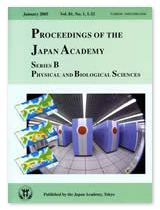About the Cover
Vol. 81 No. 1 (2005)
The Earth Simulator (ES), which is an ultra vector-parallel-type supercomputer system, is installed at the Earth Simulator Center of Yokohama Institute, the Japan Agency for Marine-Earth Science and Technology in order to understand and predict global environmental changes and to protect human being from natural disasters. Since March 2002, the ES has been operating with the highest simulation performance in the world. The ES consists of 640 processor nodes, each of which is composed of 8 vector processors with 16 Gbytes shared memory, an interconnection network, a hard disk with capacity of 690 Tbytes, and a cartridge tape library with capacity of 1.5 Pbytes. Many scientific results such as earthquake and typhoon simulations which will impact on social and economic activities have been obtained since the beginning of its operation.
Three inset figures on the left show seismic wave propagation of a hypothetical Nankai-trough earthquake (magnitude 8) at 25.2, 63.6 and 115.2 seconds after the earthquake occurs. The results derived from a large-scale finite difference method using the ES demonstrate that a large ground shaking radiates from the source region located off Kii Peninsula and propagates along the fault rupture. Increased intensity during the propagation is due to the amplification of ground motions in soft sedimentary basins including Osaka, Nagoya and Tokyo areas. Such subduction-zone earthquakes also produce long-period ground motions that propagate for long distances without attenuation. The results also demonstrate that the long-period shaking (5 -10 seconds in period range) dominates in the center of Kanto basin. (Description provided by Ikuo Kushiro, Member, the Japan Academy)




